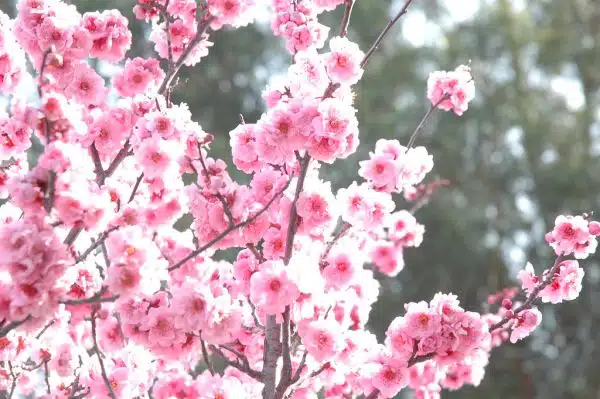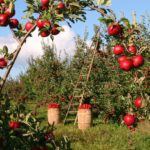Sweet cherry trees are one of the most popular fruit trees for home orchards, providing delicious and nutritious fruits for fresh eating or processing into jams, jellies, and other preserves. However, growing sweet cherry trees can be a challenging task due to their specific requirements for soil type, climate, and pruning techniques. To successfully cultivate healthy and productive sweet cherry trees, it is important to understand their growth habits, cultural needs, and pest management strategies.
In this article, we will provide a comprehensive guide on how to grow sweet cherry trees from planting to harvest. We will cover the key factors that affect sweet cherry tree growth and yield, including site selection, soil preparation, irrigation methods, fertilization practices, pest control measures, and pruning techniques. By following these tips and recommendations based on scientific research and practical experience in horticulture and arboriculture fields, you can enjoy abundant crops of juicy and flavorful sweet cherries from your own backyard orchard.
Choosing The Right Variety Of Sweet Cherry Tree
When it comes to growing sweet cherry trees, the first step is choosing the right variety. There are numerous best varieties of sweet cherry trees available in the market, and selecting one that suits your climate conditions is crucial. It’s important to keep in mind that not all varieties will thrive in every climate, so it’s essential to do some research before making a final decision.
When considering which variety of sweet cherry tree to plant, it’s important to take into account the climatic conditions of your area. Typically, sweet cherries grow best in areas with cold winters and warm summers. However, many newer cultivars have been developed that can withstand warmer temperatures as well. Climate considerations such as frost dates and chill hours play a significant role in determining which varieties are best suited for your area.
In conclusion, selecting the right variety of sweet cherry tree is an essential first step towards successful cultivation. Before making a final decision on what type to plant, it’s important to consider factors like climate and growing conditions. By doing so, you’ll set yourself up for success and increase your chances of having a healthy, productive crop. Once you have chosen the best varieties for your region based on climate considerations, it’s time to move on to site selection and preparation.
Site Selection And Preparation
Now that you’ve selected the perfect variety of sweet cherry tree for your garden, it’s time to move on to the next step: site selection and preparation. Choosing the right location is crucial for the success of your trees, as it affects their growth, fruit production, and overall health.
Climate considerations are one of the most important factors to keep in mind when selecting a site for your sweet cherry trees. These trees prefer temperate climates with moderate winters and mild summers. They require a certain amount of chill hours during their dormant period to produce high-quality fruit. Therefore, it’s essential to choose a location that provides enough cold weather during the winter months.
Another crucial aspect of site selection is tree spacing. Sweet cherry trees need plenty of room to grow and develop properly. The recommended spacing between trees is 20-25 feet apart, depending on the variety’s size. This distance allows sufficient sunlight exposure and air circulation around each tree, reducing disease pressure and improving fruit quality.
- Proper drainage: Sweet cherry trees prefer well-drained soil that doesn’t retain excess moisture.
- Soil pH: The ideal soil pH range for sweet cherry trees is between 6.0-7.5.
- Soil type: These trees thrive in loamy or sandy soils with good organic matter content.
By now, you know how crucial it is to select an appropriate site for your sweet cherry trees based on climate considerations and proper tree spacing. However, there’s one more critical factor you need to consider before planting: soil requirements for sweet cherry trees. In the next section, we’ll discuss everything you need to know about soil types, pH levels, nutrients, and amendments necessary to ensure optimal tree growth and fruit production.
Soil Requirements For Sweet Cherry Trees
For sweet cherry trees to grow optimally, soil testing is essential. Before planting the trees, a thorough analysis of the soil should be conducted to determine its pH level and nutrient content. This will enable one to make informed decisions about what type of fertilizers or amendments to apply to the soil to ensure that it has adequate nutrients for tree growth.
Sweet cherry trees require well-draining soil that is rich in organic matter. The ideal pH level for optimal growth is between 6.0 and 7.0. If the soil is too acidic (below pH 6), lime can be added to raise the pH level. On the other hand, if the soil is too alkaline (above pH 7), sulfur can be added to lower the pH level.
Nutrient deficiencies are a common problem in sweet cherry trees, which can lead to stunted growth and poor fruit production. Nitrogen, phosphorus, and potassium are essential nutrients required by these trees for healthy growth. A soil test can help identify any nutrient deficiencies and allow one to apply appropriate fertilizers or amendments that will correct any imbalances in nutrient levels.
Moving on from soil requirements, irrigation methods are also crucial for optimal growth of sweet cherry trees.
Irrigation Methods For Optimal Growth
Having the right soil and ensuring it is properly irrigated are crucial factors in successfully growing sweet cherry trees. As we have discussed in the previous section, sweet cherry trees require well-drained soil that is rich in nutrients. However, water management is equally important to ensure optimal growth.
One of the most effective irrigation methods for sweet cherries is drip irrigation. This method provides water directly to the roots of the tree, reducing water loss through evaporation and minimizing weed growth. Drip irrigation also helps regulate soil moisture levels, preventing overwatering and underwatering which can be detrimental to the health of the tree.
Alternatively, sprinkler systems can also be used for irrigating sweet cherry trees. However, it is important to avoid watering too frequently or too heavily as this can lead to shallow root growth and disease susceptibility. Ideally, sprinklers should be set up so that they do not wet the leaves or fruit of the tree, as this can promote fungal growth and other diseases that may affect yield.
Proper irrigation practices are essential for growing healthy sweet cherry trees with high yields. In the subsequent section, we will discuss fertilization practices that can further enhance tree growth and productivity. By incorporating these best practices into your orchard management plan, you can achieve optimal results and consistently produce high-quality sweet cherries year after year.
Fertilization Practices For Higher Yield
To achieve higher yields in sweet cherry trees, proper fertilization practices must be employed. There are two types of fertilizers that can be used to nourish the cherry trees: organic and synthetic fertilizers. The choice between the two depends on personal preference, cost, and environmental factors.
Organic fertilizers are derived from natural sources and contain a variety of nutrients that promote healthy tree growth. Examples of organic fertilizers include composted manure, bone meal, blood meal, and fish emulsion. These types of fertilizers are slow-release and provide sustained nutrition to the cherry trees over time. They also improve soil health by increasing microbial activity and nutrient availability.
Synthetic fertilizers, on the other hand, are chemically formulated and provide an immediate boost of nutrients to the cherry trees. They are usually less expensive than organic fertilizers but can have negative impacts on the environment if not used properly. Synthetic fertilizers can also lead to excessive vegetative growth in cherry trees which may result in decreased fruit production.
In summary, both organic and synthetic fertilizers can be effective in promoting higher yields in sweet cherry trees. The choice between the two depends on personal preference as well as environmental factors such as soil health and impact on surrounding ecosystems. It is important to use fertilizer properly in order to avoid negative impacts on tree growth or downstream ecosystems. In the next section, we will discuss pest control strategies for maintaining healthy sweet cherry trees without relying heavily on chemical interventions.
Pest Control Strategies
- Growing sweet cherry trees requires an understanding of the pests that are most likely to cause damage.
- Taking preventive measures to control pests is the best way to ensure the health of the tree. These measures include proper pruning and sanitation, as well as monitoring for signs of pests.
- Organic solutions for pest control include the use of beneficial insects and the application of natural pest repellents.
- Sanitation is an important part of pest control, as it helps to reduce the number of pests that are present in the area.
- Beneficial insects, such as ladybugs and lacewings, can be used to control pests by preying on them.
- Natural pest repellents, such as garlic, neem oil, and hot pepper spray, can be used to repel pests that may be damaging the tree.
Identifying Pests
Identifying Pests is an important step in ensuring the health and productivity of sweet cherry trees. Some common pests that can affect sweet cherry trees include aphids, mites, fruit flies, and cherry slugs. Aphids are small insects that feed on the sap of leaves and can cause wilting or yellowing of leaves. Mites are another common pest that can damage the leaves and fruit of sweet cherry trees, causing discoloration or deformation. Fruit flies can also be a problem for sweet cherry growers as they lay eggs inside the fruit which then hatch into maggots.
Preventative measures are key to controlling pests in sweet cherry trees. Maintaining proper sanitation practices, such as removing fallen fruit and debris from around the tree, can help reduce infestations. Additionally, using sticky traps can help catch flying insects like fruit flies before they have a chance to lay their eggs in the fruit. Natural remedies such as neem oil and insecticidal soap can also be effective at controlling pests without harming beneficial insects like bees.
Regular monitoring of sweet cherry trees is crucial for identifying pest problems early on. By checking for signs of infestations, such as leaf damage or discoloration, growers can take preventative measures before the problem becomes too severe. Integrated Pest Management (IPM) strategies that combine cultural practices with natural remedies are often most effective at controlling pests while minimizing harm to the environment.
In conclusion, identifying pests in sweet cherry trees is essential for maintaining healthy and productive orchards. Growers should take preventative measures by maintaining good sanitation practices and using natural remedies whenever possible to control pest populations. Regular monitoring of tree health is also crucial for catching any problems early on before they become too severe.
Preventative Measures
Integrated pest and disease management is crucial in maintaining healthy sweet cherry trees. Preventative measures play a significant role in controlling pests from ravaging the orchard. Good sanitation practices, such as removing fallen fruit and debris from around the tree, help reduce infestations. This practice is essential because it eliminates breeding grounds for pests that may cause diseases.
Weather-related issues like drought or extreme temperatures can make sweet cherry trees more susceptible to pest infestations. Therefore, growers must take preventative measures to address these issues. For example, irrigation systems can help maintain adequate soil moisture levels during dry periods, preventing stress on the trees that may lead to pest problems. Moreover, field monitoring helps detect any signs of weather-related stress early on before they cause significant damage.
Prevention is always better than cure when it comes to controlling pests in sweet cherry trees. Growers should implement an Integrated Pest Management (IPM) strategy that combines cultural practices with natural remedies for effective pest management while minimizing harm to the environment. By adopting these preventative measures and being proactive about monitoring tree health regularly, growers can ensure their sweet cherry orchards remain healthy and productive for years to come.
Organic Solutions
Another critical aspect of pest control strategies in sweet cherry trees is the use of organic solutions. Organic pest control methods involve using natural substances that are safe for humans and the environment to manage pests. The use of synthetic pesticides can harm beneficial insects, birds, and animals, which may disrupt the delicate balance of the ecosystem. Therefore, growers should consider using organic pest control strategies to maintain a healthy orchard.
One effective method of organic pest control is companion planting. Companion planting involves growing two or more plants together that have a mutually beneficial relationship. For example, planting marigolds around sweet cherry trees can help repel nematodes and other harmful insects while attracting beneficial ones like ladybugs and honeybees. Additionally, intercropping with legumes like clover and beans can fix nitrogen in the soil, enhancing tree growth and fruit production.
In conclusion, organic pest control methods such as companion planting play a significant role in maintaining healthy sweet cherry trees without causing harm to the environment or human health. By incorporating these methods into their Integrated Pest Management (IPM) strategy, growers can effectively manage pests while promoting sustainability in their orchards. Ultimately, adopting an eco-friendly approach to pest management helps ensure that sweet cherry production remains sustainable for generations to come.
Pruning Techniques For Shape And Productivity
To maintain the shape and productivity of sweet cherry trees, pruning is essential. There are two types of pruning that can be done throughout the year: summer pruning and winter pruning. Summer pruning should be done during the growing season to keep the tree’s size manageable and prevent shading of lower branches. Winter pruning, on the other hand, should be done while trees are dormant to remove dead or diseased wood.
When it comes to shaping sweet cherry trees, training branches is crucial. Begin by selecting a central leader branch and removing any competing leaders. Scaffold branches should be trained to grow at a 45-degree angle from the trunk and spaced at regular intervals around the central leader branch. As the tree grows taller, additional scaffolds may need to be added for stability.
To increase productivity, it’s important to remove suckers that emerge from below graft unions or along the base of the trunk. Suckers can take energy away from fruit production and lead to unproductive growth. Additionally, thinning out excessive fruit clusters will allow for larger, higher quality cherries.
- Regular pruning not only improves tree health but also increases yield.
- Neglected trees with overgrown branches often have smaller fruits.
- Properly pruned trees have improved air circulation which reduces fungal diseases.
- The benefits of pruning include easier harvesting and prevention of limb breakage from heavy fruit loads.
- Well-pruned trees look aesthetically pleasing in landscapes.
Next, we’ll cover how to harvest and store sweet cherries so you can enjoy your fruitful efforts throughout the year.
Harvesting And Storing Sweet Cherries
Once sweet cherries have ripened on the tree, they are ready to be harvested. It is important to harvest them at the right time as overripe cherries tend to become soft and may not store well. Harvesting should be done in the morning when the fruits are cool and firm. The fruit stem should be left intact during harvesting, as this helps to increase their storage life.
After harvesting, it is essential to store sweet cherries properly. They can be stored for a short duration of 2-3 days in a refrigerator or up to 10 days if kept in a humid environment such as a cellar or basement. However, it is important to ensure that the cherries are not exposed to moisture, which could lead to fungal growth and spoilage.
Cherry tree care plays an essential role in ensuring high-quality fruit production. Proper pruning techniques help maintain tree structure while also promoting fruit yield. Maintaining adequate soil moisture levels and providing nutrients such as nitrogen, phosphorus, and potassium are vital for healthy cherry trees. Additionally, regular monitoring for pests and diseases will help prevent potential damage that could negatively impact fruit production.
Delicious cherry recipes can make use of your freshly harvested or stored sweet cherries. From pies, tarts, jams to cocktails, there are endless possibilities for incorporating these juicy fruits into your meals or snacks. With proper harvesting techniques and adequate storage practices, you can enjoy your homegrown sweet cherries throughout the year.
Moving forward into identifying common problems and solutions for sweet cherry trees…
Common Problems And Solutions For Sweet Cherry Trees
As we’ve learned in the previous section, harvesting and storing sweet cherries require careful handling to ensure the fruit’s quality. But before we get to that stage, it’s crucial to focus on preventing birds and managing diseases that may affect the sweet cherry trees throughout their growth.
Birds can be a significant problem for sweet cherry growers, as they are attracted to the fruit’s sweetness. To prevent birds from damaging your crop, you can use physical barriers such as netting or reflective tape. Netting can be draped over the trees or used to cover individual branches, while reflective tape creates a flashing effect that discourages birds from landing on the trees.
In addition to bird control measures, it’s also essential to manage diseases and pests that may harm your sweet cherry trees. Common diseases include brown rot, powdery mildew, and bacterial canker. Using fungicides or applying dormant sprays can help prevent these diseases from taking hold. Monitoring for pests like aphids or mites is also essential since infestations can weaken the tree and reduce fruit production. Regular pruning of dead or diseased branches will also help keep your trees healthy and productive for years to come.
Moving forward, maintaining healthy and productive sweet cherry trees requires proactive management practices such as regular fertilization, pruning, monitoring for pests and diseases, irrigation management during drought periods, and winter protection techniques in cold climates. With proper care and attention throughout the growing season, you’ll enjoy bountiful harvests of delicious sweet cherries year after year.
Tips For Maintaining Healthy And Productive Sweet Cherry Trees
Maintaining the health and productivity of sweet cherry trees is crucial for ensuring a bountiful harvest. To achieve this, it is essential to practice the best pruning techniques. Pruning should be done annually during the dormant season, typically from late winter to early spring when the tree is not actively growing. This process involves removing dead wood, water sprouts, and crossing branches to promote healthy growth and fruit production.
In addition to pruning, keeping an eye out for common pest problems is also crucial for maintaining healthy sweet cherry trees. Some of the most common pests that affect these trees include aphids, mites, and fruit flies. Regular monitoring of the trees can help detect any infestations early on so that appropriate control measures can be taken promptly. Using natural pest control methods such as introducing beneficial insects like ladybugs or applying horticultural oils may also help prevent pest problems.
Aside from pruning and pest management, providing adequate care for sweet cherry trees is also vital for their overall health and productivity. This includes regular watering during dry periods, fertilizing in early spring before new growth appears, and ensuring sufficient sunlight exposure. Additionally, mulching around the base of the tree helps retain soil moisture while suppressing weed growth.
- Prune annually during dormant season
- Monitor regularly for common pests
- Provide adequate care such as watering, fertilizing and mulching
Maintaining healthy and productive sweet cherry trees requires diligence in pruning techniques, pest management practices, and proper care. By following these tips consistently, you can ensure a bountiful harvest year after year without compromising on quality or flavor. Remember to always stay vigilant in your efforts to keep your sweet cherry trees thriving!
Conclusion
When it comes to growing sweet cherry trees, there are several factors to consider for optimal growth and productivity. Selecting the right variety, preparing the site, ensuring proper soil and irrigation, practicing fertilization and pruning techniques, and harvesting and storing correctly are all crucial steps in the process.
However, even with careful attention to these steps, problems may still arise. Pests and diseases can wreak havoc on your trees, causing crop loss or reduced quality. But fear not! With proper identification and treatment methods, many of these issues can be resolved.
In conclusion, growing sweet cherry trees can be a rewarding experience for any horticulturalist or arborist. By following the guidelines outlined above and staying vigilant against potential problems, you can enjoy a bountiful harvest of delicious cherries year after year. Happy planting!
Image Credits
- “Light filled sweet cheery cherry tree blossoms, San Mateo, California, USA” by Wonderlane (featured)





























